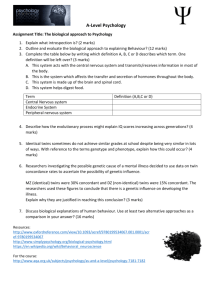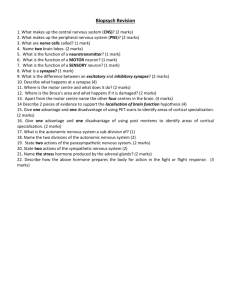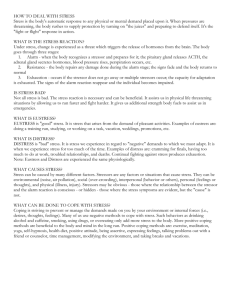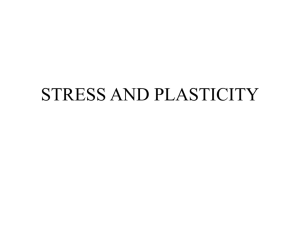Stress Revision Test
advertisement
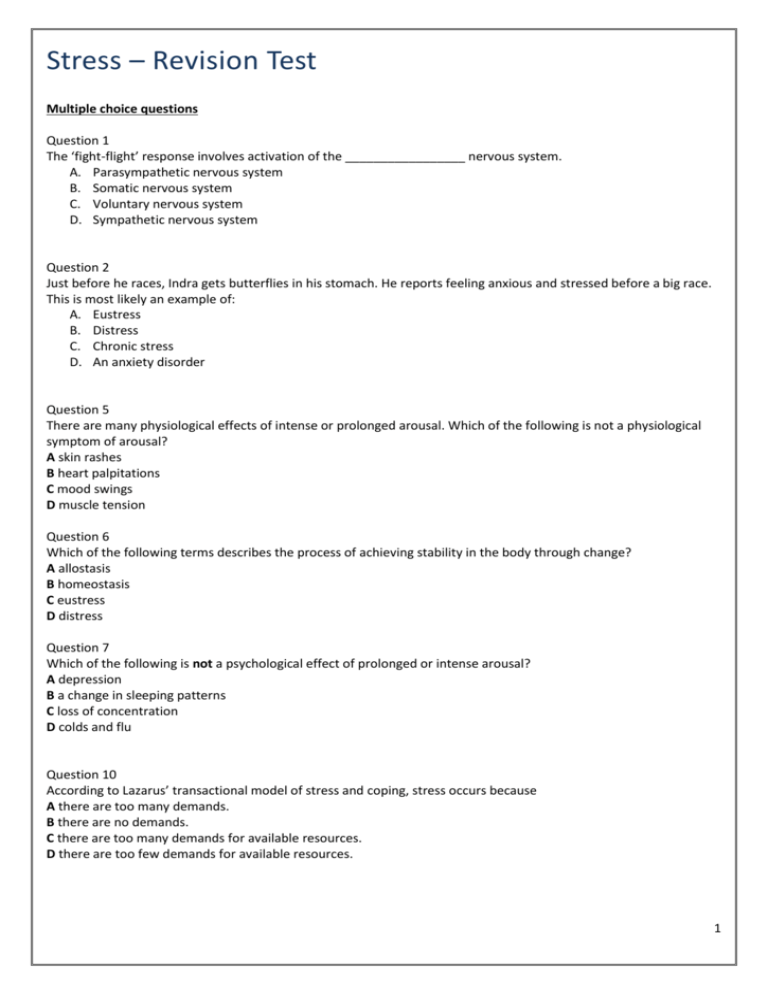
Stress – Revision Test Multiple choice questions Question 1 The ‘fight-flight’ response involves activation of the _________________ nervous system. A. Parasympathetic nervous system B. Somatic nervous system C. Voluntary nervous system D. Sympathetic nervous system Question 2 Just before he races, Indra gets butterflies in his stomach. He reports feeling anxious and stressed before a big race. This is most likely an example of: A. Eustress B. Distress C. Chronic stress D. An anxiety disorder Question 5 There are many physiological effects of intense or prolonged arousal. Which of the following is not a physiological symptom of arousal? A skin rashes B heart palpitations C mood swings D muscle tension Question 6 Which of the following terms describes the process of achieving stability in the body through change? A allostasis B homeostasis C eustress D distress Question 7 Which of the following is not a psychological effect of prolonged or intense arousal? A depression B a change in sleeping patterns C loss of concentration D colds and flu Question 10 According to Lazarus’ transactional model of stress and coping, stress occurs because A there are too many demands. B there are no demands. C there are too many demands for available resources. D there are too few demands for available resources. 1 Question 11 Which of the following is not considered a beneficial technique for coping with stress? A drinking alcohol B relaxation C biofeedback D physical exercise Questions 12 and 13 refer to the following information. When Lauren went out on her first date with her boyfriend, Matt, she was very nervous. Her hands were shaky, she had trouble concentrating and she didn’t have much of an appetite. Question 12 For Lauren, the date itself is best described as A a stressor. B a stress reaction. C a stress system. D stress. Question 13 Lauren’s loss of appetite is best described as A a stressor. B a stress reaction. C a stress system. D stress. Question 15 ‘Allostatic load’ refers to A the wear and tear that the body experiences due to cycles of allostasis. B the process of achieving stability through change. C the body’s way of maintaining balance and equilibrium. D the amount of stress someone is under. Short answer questions Question 1 Matt’s mother tells him that he should find a way to relieve the stress that he suffers as a result of his hectic work schedule. Name two physiological effects the Matt may experience if he does suffer prolonged stress. _______________________________________________________________________________________________ _______________________________________________________________________________________________ _______________________________________________________________________________________________ 2 marks Question 3 Describe two strategies that can be used to help cope with stress. _______________________________________________________________________________________________ _______________________________________________________________________________________________ 2 marks 2 Question 4 a Discuss one physiological response that increases when the fight–flight response is activated and one physiological response that decreases. Increases: ______________________________________________________________________________________ Decreases: ______________________________________________________________________________________ b Explain why some responses increase and others decrease when the body is in a state of heightened arousal. _______________________________________________________________________________________________ _______________________________________________________________________________________________ 2 + 1 = 3 marks Question 6 Dr Foyster is conducting an experiment into the effects of meditation on stress relief. He hopes to find that stress is decreased during a meditative state, so when estimating the meditation group’s stress levels he is very generous in estimating the program’s effectiveness. He is not so generous when estimating the control group’s stress levels. Dr Foyster’s study has been subjected to a)___________________, which can be minimised through the implementation of a b) ________________ procedure. a) ____________________________________________________________ b) ____________________________________________________________ 2 marks Question 7 Explain what the term ‘allostasis’ means. _______________________________________________________________________________________________ _______________________________________________________________________________________________ 1 mark Question 8 a What is the fight–flight response? Use a real-life example to explain your answer. _______________________________________________________________________________________________ _______________________________________________________________________________________________ _______________________________________________________________________________________________ b Which nervous system activates the fight–flight response? _______________________________________________________________________________________________ c What purpose does the fight–flight response serve? _______________________________________________________________________________________________ _______________________________________________________________________________________________ 2 + 1 + 1 = 4 marks 3 Question 9 Explain the difference between ‘eustress’ and ‘distress’. _______________________________________________________________________________________________ _______________________________________________________________________________________________ _______________________________________________________________________________________________ 2 marks Question 10 Explain two ways that stress can be reduced according to Lazarus’ transactional model of stress and coping. _______________________________________________________________________________________________ _______________________________________________________________________________________________ _______________________________________________________________________________________________ 2 marks Question 11 What is the difference between ‘homeostasis’ and ‘allostasis’? _______________________________________________________________________________________________ _______________________________________________________________________________________________ 2 marks 4 Solutions Multiple choice 1.D 2.A 5.C 6.A 7.D 8.B 9.B 10.C 11.A 12.A 13.B 15.A Short answer 1. List any two of the following: stomach ulcers; heart palpitations; skin rashes; fatigue; colds and flu; headaches; immune system weakening. 3. Any two of the following: biofeedback can be used to try to reduce physiological responses such as heart rate and respiration to calm an individual; meditation/relaxation can help reduce heart and respiratory rate to calm an individual; physical exercise can help alleviate stress as it uses adrenalin that has been released during a stress response; social support can be important for coping with stress to allow an individual to strategise and prioritise. 4.a) increases: Heart rate, respiratory rate, production of sweat. Decreases: Production of saliva, production of bile and stomach contractions. b) The body maximises its chance of survival by distributing its resources to the areas that need it most. 6. experimenter effects, double-blind 7. Allostasis is the process of achieving stability through physiological or behavioural change 8a. The fight–flight response is a sympathetic nervous system response that prepares the body to deal with a potential threat by choosing to either confront the threat or run from a potential danger. For example, if someone is following you late at night, the fight–flight response will give you the necessary resources to attack the person (fight) or to run away from them (flight). b. The sympathetic nervous system. c. It distributes the body’s resources to maximise the individual’s chance of survival. 9. Eustress means ‘good stress’ – it is stress that is healthy and provides positive outcomes. Distress is a negative form of stress, which can lead to negative health outcomes. 10. Any two of the following: by changing an individual’s perception of stress; to see stress as challenging rather than a threat; to align an individual with strategies to help them cope; to improve confidence in an individual’s ability to cope. 11. Homeostasis refers to the body’s ability to maintain a stable and constant internal environment, whereas allostasis is the process of maintaining this stability through change. 5

